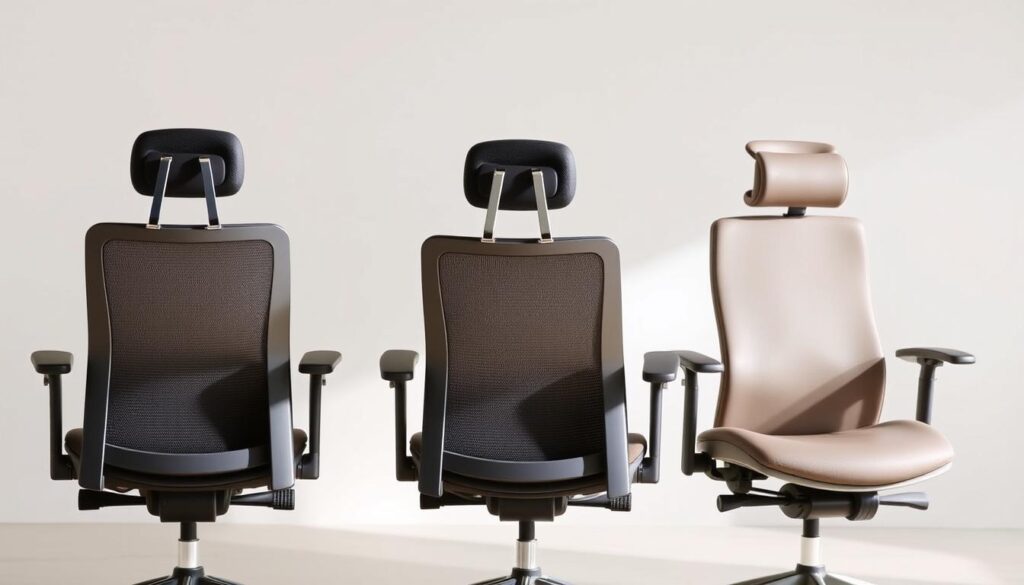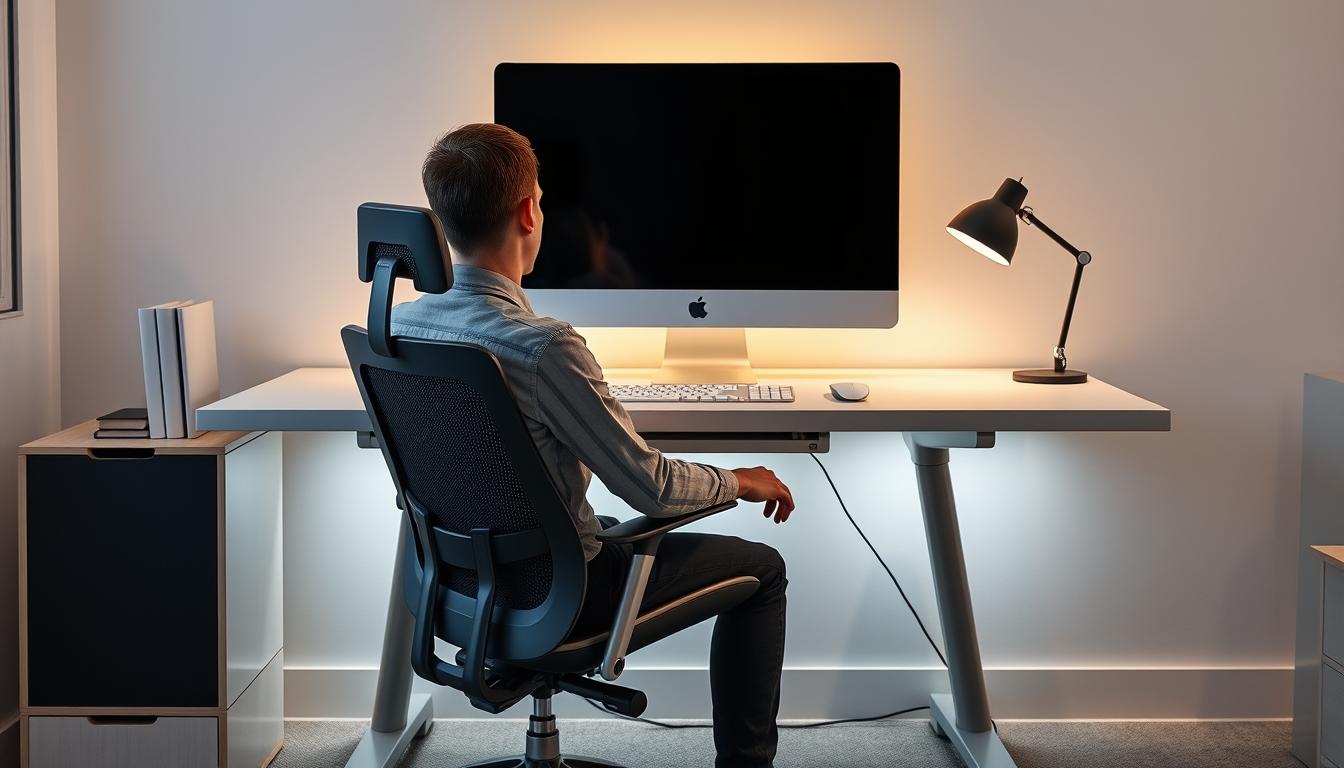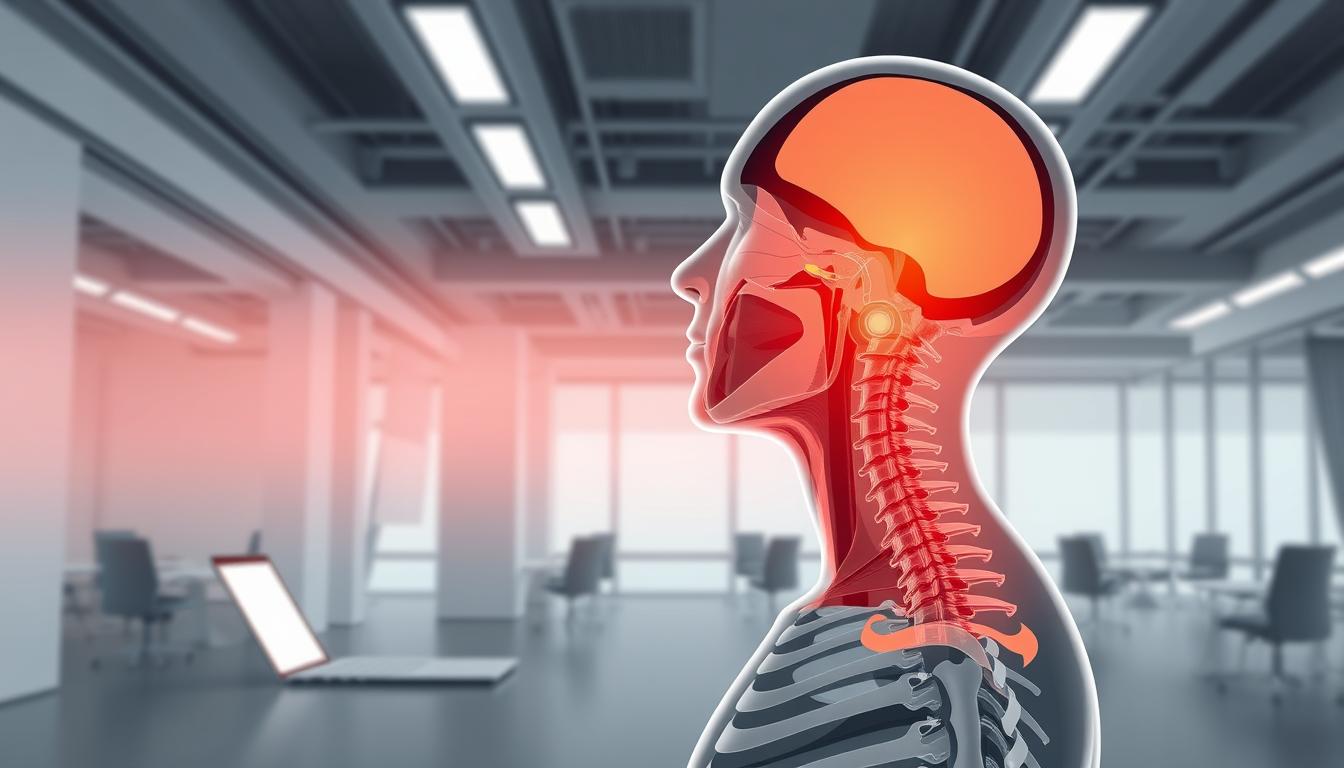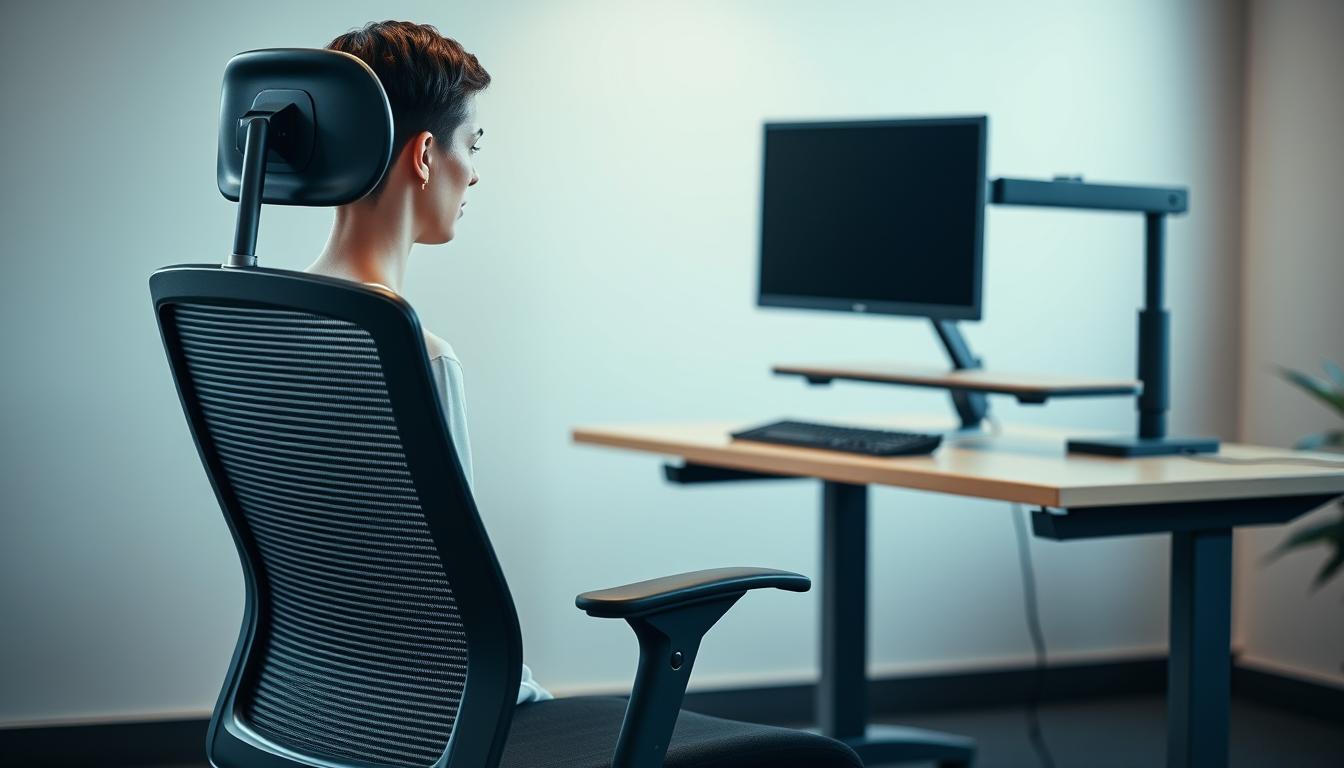Picking the right ergonomic chair is key to getting good neck support and feeling comfy at work. This guide aims to make the process easier, highlighting how your sitting posture affects your neck. Ergonomic chairs help improve your posture, lessen strain from sitting too long, and make your workday better.
Throughout this guide, we’ll explore different chair features and their benefits. This will help you choose a chair that’s best for your neck and comfort in the long run.
Understanding Ergonomics and Neck Support
Ergonomics is about making designs that focus on people’s comfort and effectiveness, especially at work. It adjusts environments and furniture to fit personal needs. This cuts down on discomfort and injury risks. Knowing how ergonomics affects workplace comfort and health is very important.
Definition and Importance of Ergonomics
Ergonomics is the study of making work spaces better suit human needs. It makes sure work areas, tools, and tasks fit our abilities and limits. Focusing on ergonomics brings big benefits like more work done and fewer muscle pains.
How Ergonomics Affects Neck Health
Ignoring ergonomics can hurt your neck. A good ergonomic chair helps keep your spine healthy by encouraging the right sitting posture. When chairs support your body and keep your spine straight, your neck and shoulders feel less strained. This is crucial for avoiding neck pain from sitting too long.
Why a Good Chair Matters
Picking the right office chair boosts comfort and work quality. An uneasy chair can distract and harm job performance. Workers may take more breaks if they feel uncomfortable, hurting productivity. A good ergonomic chair helps people focus on their work without feeling any discomfort.
Impact on Productivity and Comfort
Being comfy at work is key to staying productive. Ergonomic chairs support the body and increase comfort. This lets employees concentrate better, making them more productive. Without discomfort, people can do better in their tasks.
Long-Term Health Benefits
A proper office chair can prevent chronic pain and other health issues. It helps with avoiding pain by supporting good posture all day. This way, companies support their employees’ health, leading to fewer sick days.
Key Features of an Ergonomic Chair
When choosing an ergonomic chair, it’s important to know its key features. These features, like adjustable headrests, lumbar support, and seat adjustments, improve health and comfort. They make sure the chair fits just right, keeping you well-supported all day.
Adjustable Headrest
An ergonomic chair’s headrest is crucial for your neck’s comfort. It lets you change the headrest’s height and angle. This means you can find the perfect spot for your neck, avoiding pain and discomfort. Boulies and their OP300 model show how adjusting your headrest can make a big difference, ensuring you’re always sitting right.
Lumbar Support
The design of an ergonomic chair includes lumbar support. This supports your spine’s natural curve, keeping you aligned properly. It lines up your hips, shoulders, and ears, preventing back pain. Adjusting your chair for lumbar support greatly improves your posture and comfort during long hours of sitting.
Seat Height and Depth Adjustments
Adjusting the seat height and depth of your chair is vital for a perfect fit. These adjustments ensure your feet rest flat on the floor and your knees are right-angled. They cater to all body types for maximum comfort. Getting the seat height right also promotes good blood flow while you’re sitting for a long time.
How to Choose an Ergonomic Chair for Neck Support
Picking the right ergonomic chair is crucial for your neck and overall comfort. It involves several important steps. A good chair not only makes you more productive but is also important for your health in the long run. By knowing how to look for personal fit and features, making the right choice becomes easier.
Factors to Consider
Here’s what to keep an eye out for in an ergonomic chair:
- Adjustability of the headrest to provide optimal neck support.
- Quality lumbar support for maintaining spinal alignment.
- Seat height and depth adjustments, necessary for individual body proportions.
Try out different chairs to see which one supports good posture. This helps prevent neck pain. Take your time to check out the chair’s functions.
Common Mistakes to Avoid
People often slip up when choosing an ergonomic chair. Here are some errors to dodge:
- Ignoring lumbar support, which plays a crucial role in overall back health.
- Neglecting adjustability options that can vastly improve comfort.
- Failing to test the chair before buying it, which can result in a bad fit.
Looking at reviews and feedback can show how well a chair supports the neck. Remember these tips for a chair that’s both comfortable and good for you.
Types of Ergonomic Chairs
Choosing the right ergonomic chair is key to better comfort and posture while working. Different types cater to various needs and offer unique benefits for your back and comfort.
Kneeling Chairs and Their Benefits
Kneeling chairs help improve your spine’s alignment and reduce lower back pressure. They make you lean forward, which helps in keeping a good posture and spreading your weight evenly. These chairs also support your legs well, making sitting more comfortable than traditional chairs for many. But, they might not be the best choice for people with knee problems or those who prefer standard chairs.
Saddle Chairs for Improved Posture
Saddle chairs are getting popular, especially among dentists and health professionals. They keep you upright, engaging your core and encouraging better posture. This decreases the chance of back and neck pain, making them a great option over regular office chairs. They meet the ergonomic needs of various users well.
Traditional Office Chairs with Ergonomic Features
Many office chairs now come with ergonomic features for better spine support and comfort. They often have adjustable back support, seat heights, and more to fit everybody. These adjustments make them adaptable for different shapes and sitting preferences. They let users enjoy comfortable seating that also supports health and work productivity.
Testing Ergonomic Chairs
Testing ergonomic chairs is crucial for finding the perfect match for you. When you try out different chairs, you can see if they fit your body and what you like. It’s important to check if the chair is comfortable, supports you well, and can be adjusted easily. Going to a store and trying chairs helps you pick the best one.
Determining the Right Fit
For the best comfort, it’s key to pick a chair that can be adjusted to fit you just right. Look for a chair that feels good and keeps your spine straight. Also, make sure you can easily tweak the chair’s settings to fit your needs perfectly.
Trial Period and Adjustability
Getting to try an ergonomic chair for a few days is very helpful. This time lets you really see if the chair is comfortable for long use. You’ll get to know if its adjustments work well for your daily tasks. A chair that you can adjust well makes a big difference for your comfort and your neck and back health.
Setting Up Your Workspace for Neck Health
It’s very important to create an ergonomic workspace for your neck health and comfort at work. A good desk setup keeps your body properly aligned. This lowers your chance of getting hurt. Make sure your desk and monitor are at the right height. Also, use ergonomic tools to help keep your posture right.
Desk Height and Monitor Position
Having your desk at the right height is key for a good work setup. Your elbows should be at a 90-degree angle when you type. The height of your monitor is just as crucial. It should be at eye level. This stops your neck from straining. When your monitor is at the right height, it keeps your head in a natural position. This makes working more comfortable.
The Role of Accessories in Ergonomics
Using ergonomic accessories can make a big difference in how comfortable and supported you feel at your desk. Things like keyboard trays, footrests, and monitor stands are really important. They help you keep your body in the right position. This means you can work longer without feeling uncomfortable. By getting these helpful products, you can make a workspace that’s better for your neck. It also helps you do more work.
Maintaining Good Posture While Seated
Having the right posture is key to feeling good and staying healthy. It helps keep your spine straight, lowering the chance of pain in your back and neck. Good posture also makes you feel more energetic and less tired, especially when you sit and work for a long time.
Once you have a workspace that supports your posture, you might have to make some changes. This is because making your space more comfortable is something that happens gradually. It’s important to keep checking if your desk and chair are the right height, and your monitor is in the best spot for you.
- Maintain a neutral spine position to support back health.
- Adjust your chair to allow feet to rest flat on the floor, enhancing comfort.
- Position your monitor at eye level to reduce neck strain.
- Use wrist supports to promote ergonomic advantages while typing.
By making these changes part of your daily life, you can avoid discomfort. This ensures your workplace is best for your sitting health.
Product Recommendations for Neck Support
Looking for the right ergonomic chair can greatly improve neck support and comfort for long work sessions. The best models combine adjustability with a smart design. Here are the top choices:
Top Ergonomic Chairs on the Market
The Boulies OP300 and EP460 chairs are widely praised for their ergonomic design. They offer lots of adjustments and focus on neck comfort. This makes them perfect for those who need to stay comfortable while working. Their design encourages good posture and helps to cut down on tiredness. It changes the way people feel about their workspaces.
Budget-Friendly Options
If you need a more affordable ergonomic chair, there are cheap yet quality options. These basic chairs have features like height adjustment and lumbar support. They provide good ergonomic benefits without a hefty price tag. Choosing these options means getting good value, making comfortable chairs more accessible.

Conclusion
Choosing the right ergonomic chair is key for proper neck support and office health. Important features like adjustable headrests, lumbar support, and correct seat height should be considered. These help with comfort, better posture, and overall productivity at work.
Neck support is more than just about comfort; it’s vital for long-term health. Making choices based on ergonomic tips can really boost well-being. By selecting the proper ergonomic chair, people can lessen back and neck pain, making work more pleasant and effective.
Investing in a top-quality ergonomic chair is a smart move for a healthier, more productive office. Knowing the value of neck support and applying these ideas can help employees excel and stay healthy in their jobs.



